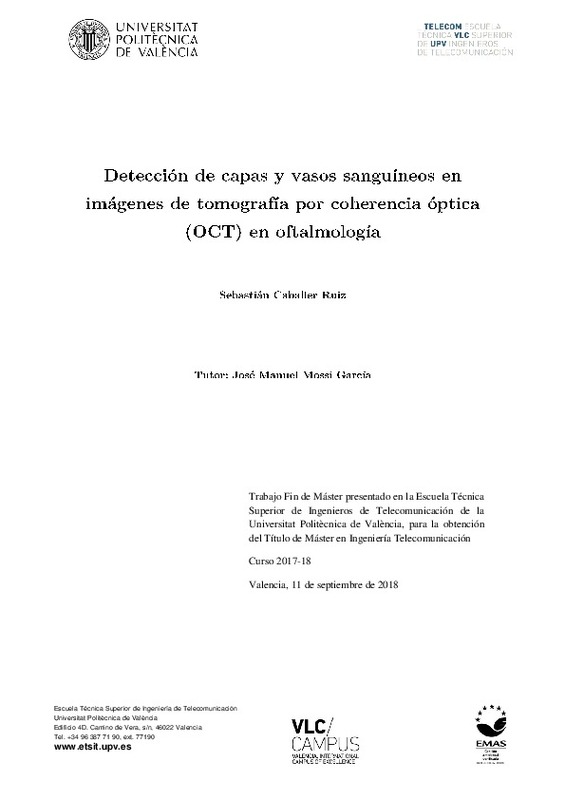JavaScript is disabled for your browser. Some features of this site may not work without it.
Buscar en RiuNet
Listar
Mi cuenta
Estadísticas
Ayuda RiuNet
Admin. UPV
Detección de capas y vasos sanguíneos en imágenes de tomografía por coherencia óptica (OCT) en oftalmología
Mostrar el registro sencillo del ítem
Ficheros en el ítem
| dc.contributor.advisor | Mossi García, José Manuel
|
es_ES |
| dc.contributor.author | Caballer Ruiz, Sebastián
|
es_ES |
| dc.date.accessioned | 2018-10-04T19:17:35Z | |
| dc.date.available | 2018-10-04T19:17:35Z | |
| dc.date.created | 2018-09-20 | es_ES |
| dc.date.issued | 2018-10-04 | es_ES |
| dc.identifier.uri | http://hdl.handle.net/10251/109406 | |
| dc.description.abstract | Proyecto desarrollado por el instituto de investigación e innovación en Bioingeniería (I3B) de la Universidad Politécnica de Valencia, junto con los doctores Jose Manuel Mossi Garcia y Valeriana Naranjo Ornedo, y el alumno Sebastián Caballer Ruiz. La medicina es un campo que ha avanzado a pasos agigantados gracias a la ingeniería biomédica, gracias al desarrollo de productos sanitarios que benefician a la salud. En este proyecto las herramientas utilizadas se centran en la mejora del campo de la oftalmología, donde las imágenes médicas cobran gran interés para facilitar el diagnóstico al oftalmólogo. El proyecto basa su estudio en el uso de imágenes OCT (Tomografía de Coherencia Óptica), uno de los mayores avances tecnológicos en el mundo de la oftalmología. El objetivo general es hacer uso de herramientas de tratamiento de imagen con el fin de facilitar el diagnóstico. Para cumplir con este propósito, se implementan interesantes algoritmos capaces de segmentar numerosas capas de la retina, y se desarrollan al mismo tiempo algoritmos por parte del departamento. Una vez comprendido el desarrollo de estos algoritmos, se ha realizado una interfaz de usuario con la que el personal médico e ingenieros, pueden probar la efectividad de los algoritmos y realizar comparaciones entre ellos de forma intuitiva. Por último, para poder llegar a un mayor número de usuarios, se desarrolla una aplicación web con la que cualquier persona acreditada pueda acceder y hacer uso de los algoritmos implementados. Mediante esta aplicación, el usuario no necesita hacer uso de un equipo de alto rendimiento y puede ser usado desde cualquier lugar. En general, el proyecto es un buen ejemplo de desarrollo, implementación de algoritmos y aplicación directa para su uso en el campo de la oftalmología y comercialización. | es_ES |
| dc.description.abstract | Project developed by the Institute of Research and Innovation in Bioengineering (I3B) of the Polytechnic University of Valencia, together with the doctors Jose Manuel Mossi Garcia and Valeriana Naranjo Ornedo, and the student Sebastián Caballer Ruiz. Medicine is a field that has advanced by leaps and bounds thanks to biomedical engineering, through the construction of health products that benefit health. This project is focused on improving the field of ophthalmology, where medical images are of great interest to facilitate the diagnosis of ophthalmology. The project bases its study on the use of OCT images (Optical Coherence Tomography), one of the greatest technological advances in the world of ophthalmology. The general objective is to make use of image processing tools in order to facilitate the diagnosis. In order to fulfill this purpose, interesting algorithms capable of segmenting numerous layers of the retina are implanted, and algorithms are developed at the same time by the department. Once the development of these algorithms is understood, a user interface has been developed with purpose of medical staff and engineers could test the effectiveness of the algorithms and make comparisons between them intuitively. Finally, in order to reach a greater number of users, a web application is developed where any accredited person can access and make use of the algorithms implemented. Through this application, the user does not need to use a high performance computer and can be used from anywhere. In general, the project is a good example of development, implementation of algorithms and a direct application for use in the field of ophthalmology and marketing. | en_EN |
| dc.language | Español | es_ES |
| dc.publisher | Universitat Politècnica de València | es_ES |
| dc.rights | Reserva de todos los derechos | es_ES |
| dc.subject | Segmentación | es_ES |
| dc.subject | Tomografía de Coherencia Óptica | es_ES |
| dc.subject | Capas de la retina | es_ES |
| dc.subject | Vasos sanguíneos | es_ES |
| dc.subject | Interfaz de usuario | es_ES |
| dc.subject | Aplicaciones web | es_ES |
| dc.subject | Segmentation | en_EN |
| dc.subject | Optical Coherence Tomography | en_EN |
| dc.subject | Retinal layers | en_EN |
| dc.subject | Blood vessels | en_EN |
| dc.subject | User interface | en_EN |
| dc.subject | Web applications | en_EN |
| dc.subject.classification | TEORIA DE LA SEÑAL Y COMUNICACIONES | es_ES |
| dc.subject.other | Máster Universitario en Ingeniería de Telecomunicación-Màster Universitari en Enginyeria de Telecomunicació | es_ES |
| dc.title | Detección de capas y vasos sanguíneos en imágenes de tomografía por coherencia óptica (OCT) en oftalmología | es_ES |
| dc.type | Tesis de máster | es_ES |
| dc.rights.accessRights | Abierto | es_ES |
| dc.contributor.affiliation | Universitat Politècnica de València. Departamento de Comunicaciones - Departament de Comunicacions | es_ES |
| dc.contributor.affiliation | Universitat Politècnica de València. Escuela Técnica Superior de Ingenieros de Telecomunicación - Escola Tècnica Superior d'Enginyers de Telecomunicació | es_ES |
| dc.description.bibliographicCitation | Caballer Ruiz, S. (2018). Detección de capas y vasos sanguíneos en imágenes de tomografía por coherencia óptica (OCT) en oftalmología. http://hdl.handle.net/10251/109406 | es_ES |
| dc.description.accrualMethod | TFGM | es_ES |
| dc.relation.pasarela | TFGM\89696 | es_ES |
Este ítem aparece en la(s) siguiente(s) colección(ones)
-
ETSIT - Trabajos académicos [2408]
Escuela Técnica Superior de Ingenieros de Telecomunicación






